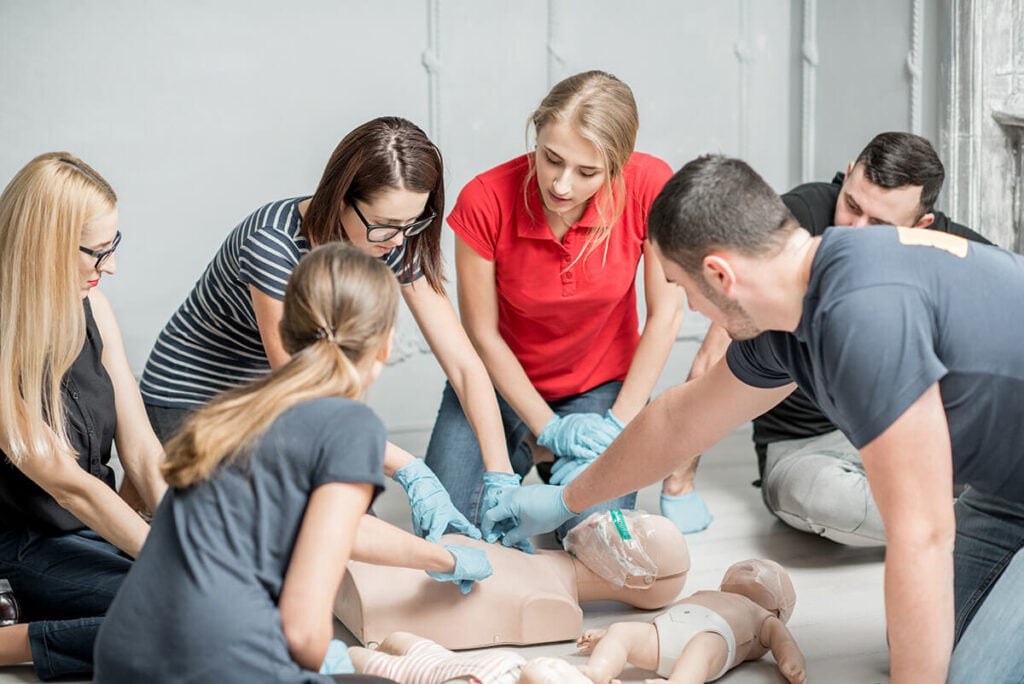
Last Updated On: December 16, 2024
Cardiopulmonary resuscitation (CPR) is a life-saving procedure used to restore blood flow in individuals experiencing cardiac arrest or who have stopped breathing. By employing chest compressions and artificial respiration, CPR mimics the heart’s natural rhythm, ensuring oxygenated blood reaches vital organs, particularly the brain, to prevent permanent damage. This essential skill can avert sudden death and is widely recognized and trusted globally. CPR certification is crucial for healthcare providers, emergency responders, and professionals working with vulnerable populations, and it is highly beneficial for anyone to learn in case of emergencies.
In the 1700s, CPR procedures were already evolving. The official recommendation was to use mouth-to-mouth resuscitation. In fact, The Academie des Sciences in Paris officially began recommending mouth-to-mouth in the middle of the century. Towards the end of the century, it was actually recommended to use bellows to inflate the lungs when someone had stopped breathing. However, the idea of chest compressions hadn’t come into play yet.
In the 1800s, the evolution of CPR procedures was somewhat slow. However, at the very end of the century, a German physician named Dr. Friedrich Maass did begin advocating for the use of chest compressions. Unfortunately, at the time, this suggestion wasn’t received well, and instead, the bulk of health professionals continued using open-heart massage as a way to get the blood flowing again.
The 1900s were when CPR procedures really began to evolve. At the very beginning of the century, Dr. George Crile was the first to report successful resuscitation using chest compressions. He actually began using chest compressions on dogs; however, that practice was quickly adopted by humans as well. By the end of the century, mouth-to-mouth resuscitation was also common practice when used in conjunction with chest compressions. At this point, modern CPR procedures, such as the American Red Cross, recommended mouth-to-mouth resuscitation for drowning victims and sudden cardiac arrest victims.
In 1963, the American Heart Association (AHA) had officially endorsed the idea of CPR, and by the 1970s, there was the global acceptance of the CPR procedures that we would consider “modern.” Alternating sets of 30 chest compressions and 2 rescue breaths became the standard for dealing with any adult suffering from heart failure. In the 1980s the American Heart Association began developing guidelines for proper infant CPR as well. Later on, in the early 2000s, the idea of hands-only CPR was introduced, and CPR guidelines were most recently updated in 2015.
The following is a list of the most notable contributions to CPR over the years:
As previously mentioned, the last major update to CPR procedures was in 2015. Training and performance standards are revisited and updated every 5 years in order to ensure that everyone is receiving the best possible information. Some of the most recent updates are as follows:
While CPR procedures have indeed gone through a significant evolution, there are current standards that have been in place for a while and should be continued to be followed.
4. Finally, it’s important that you watch to see if the victim begins breathing on their own again, as then you no longer need to administer CPR and can actually cause further damage if you do so. Lay your head next to the victim’s mouth and try to feel their breath on your cheek to determine if they’ve started breathing again.
Looking at the history of CPR gives us hope for the future. To see how far we have come and to look forward at the emerging technologies is encouraging. Here are just a few of the CPR advancements to come.
The ResQPOD device enhances circulation to the brain and the heart in patients who need assisted ventilation. The device improves cardiac arrest victims’ survival chances.
New manikins on the market provide feedback to CPR students. These manikins provide valuable information such as hand placement, compression, and ventilation volume. Simulation manikins should become a focal point for all CPR certification courses. They provide CPR students with advanced insights traditional manikins can’t.
The AHA recommends laypeople and healthcare professionals receive recertifications every two years. However, studies suggest two-year recertifications may be insufficient to retain the necessary knowledge. Because of this, the AHA may require more frequent recertification measures.
Emerging smartphone apps designed with bystander CPR in mind will make it easier for everyday citizens to administer life-saving assistance in cardiac emergencies. Some mobile apps currently send text alerts when victims need CPR assistance nearby.
Audio-visual feedback devices better equip CPR students to respond to cardiac arrest emergencies. For example, some of these devices feature a metronome to assist the responder in CPR chest compression pace.
The history of CPR demonstrates the remarkable evolution of this life-saving procedure, from its early beginnings in the 18th century to its modern, standardized techniques today. As advancements in technology and training continue to emerge, CPR remains a vital skill that can make the difference between life and death. With updates to guidelines, innovative tools like ResQPOD devices, feedback manikins, and CPR mobile apps, the future holds great promise for improving cardiac emergency response and survival rates. Whether through training or bystander action, CPR empowers individuals to step up in critical moments and save lives. Embracing these advancements and keeping CPR certifications up to date will ensure more people are equipped to provide effective care when it matters most.